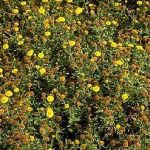| Common Name: |
Yellow Starwort |
| Other Names: |
Japanese Elecampane |
| Botanical Name: |
Inulu britannica var chinensis syn. I. japonica |
| Genus: |
Inula |
| Family: |
Asteraceae |
| Cultivation: |
Moist, well-drained soil in sun. |
| Propagation: |
By seed sown in spring or autumn; by division in spring. |
| Harvest: |
Roots are lifted in autumn and distilled for oil, used fresh to make extracts and syrup, or dried for decoctions, liquid extracts, powders and tinctures. Flower heads are picked when fully open and dried whole for use in decoctions (prepared using a muslin bag to contain irritant fibers), infusions and powder. |
| Native Location: |
China, Japan, Manchuria, and Korea |
| Height: |
20-60cm (8-24in) |
| Width: |
50cm (20in) |
| Hardiness: |
Z7 |
| Parts Used: |
Flowers (xuan fu hua) |
| Properties: |
A bitter, pungent, anti-bacterial herb that stimulates the digestive system, is expectorant, and controls vomiting. |
| Medicinal Uses: |
Internally for bronchial complaints, with profuse phlegm, nausea and vomiting, hiccups, and flatulence. Combined with honey as an expectorant, and with Glycyrrhiza glabra (See, licorice) and Zingiber officinale (See, ginger) for digestive problems characterized by excess mucus. |
| Bibliography: |
Encyclopedia of Herbs by Deni Brown. Copyright © 1995, 2001 Dorling Kindersley Limited. pg 243
|

